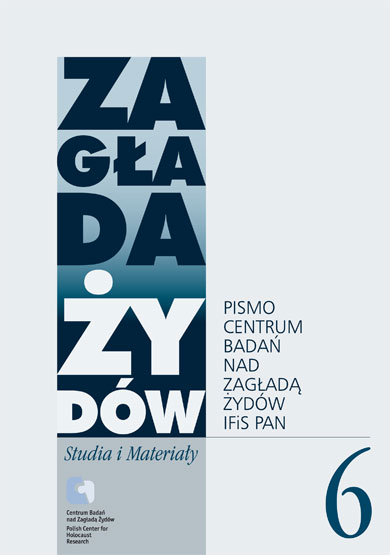Lagry w perspektywie genderowej
Zagłada Żydów. Studia i Materiały, Nr 6 (2010), Strony: 193-204
Data zgłoszenia: 2020-12-06Data publikacji: 2010-12-30
 https://doi.org/10.32927/zzsim.716
https://doi.org/10.32927/zzsim.716
Abstrakt
The questions of corporality, sexuality, women’s experience and their record examined in the context of camp issues and the Holocaust have only recently become the subject of attention. Gender studies play a significant role in the discussion on those issues. Existing works on the subject (i.a. the book of Bożena Karwowska Ciało. Seksualność. Obozy zagłady [Gender, Sexuality, Concentration Camps]) show that the tools of gender studies are cognitively useful, but, as it appears, their role of being particularly predestined to uncover what is marginalized or condemned to silence is overestimated. Nevertheless, apart from the dominance of the patriarchal discourse, there have always existed other reasons for suppressing the matter of corporality and sexuality both in works on KL’s and in science; social taboo (controlled not only by the male symbolical order) as well as the policy (e.g. it was possible to
write openly about rape on former female prisoners by Soviet soldiers only after censorship had been lifted) play an important role here. The fundamental value of the gender perspective lies in the firm approach towards the issues hitherto marginalized in the KL context – both by science and, to a lesser extent, literature (which is reflected by i.a. works of Pankowski and Posmysz published years ago).
Licencja
Prawa autorskie (c) 2010 Autor&"Zagłada Żydów. Studia i Materiały"

Utwór dostępny jest na licencji Creative Commons Uznanie autorstwa 4.0 Międzynarodowe.
https://creativecommons.org/licenses/by/4.0
Czasopismo publikowane jest w standardzie Diamond Open Access na licencji CC-BY-4.0 Deed - Uznanie autorstwa 4.0 Międzynarodowa - Creative Commons
Podobne artykuły
- Marek Hłasko, Szukając gwaizd , Zagłada Żydów. Studia i Materiały: Nr 4 (2008)
- Paweł Dobrosielski, Opowiadanie Marka Hłaski „Szukając gwiazd” jako parabola Holokaustu i mityczne „wydarzenie początkowe” w twórczości pisarza , Zagłada Żydów. Studia i Materiały: Nr 4 (2008)
- joanna Nalewajko-Kulikov, Trzy kolory: szary. Szkic do portretu Bernarda Marka , Zagłada Żydów. Studia i Materiały: Nr 4 (2008)
- Grzegorz Berendt, Cena życia ─ ekonomiczne uwarunkowania egzystencji Żydów po "aryjskiej stronie" , Zagłada Żydów. Studia i Materiały: Nr 4 (2008)
- Małgorzata Melchior, TEC Nechama, Resilience and Courage. Women, Men, and the Holocaust , Zagłada Żydów. Studia i Materiały: Nr 2 (2006)
- Sławomir Buryła, Kertzer David, Papieże a Żydzi , Zagłada Żydów. Studia i Materiały: Nr 2 (2006)
- Lars Jockheck, Od agenta do kolaboranta? Współpraca żydowskiego publicysty Fritza Seiftera z Bielska z władzami niemieckimi w latach trzydziestych i czterdziestych , Zagłada Żydów. Studia i Materiały: Nr 2 (2006)
- Aleksandra Ubertowska, The Comforting Power of Kitsch. The (Esthetic) Meanders of Holocaust Literature , Zagłada Żydów. Studia i Materiały: 2010: Holocaust Studies and Materials
- Jacek Leociak, Geographies of the Holocaust, red. Anne Kelly Knowles, Tim Cole, Alberto Giordano, Bloomington–Indianapolis: Indiana University Press, 2014, 260 s. , Zagłada Żydów. Studia i Materiały: Nr 14 (2018)
- Daniel Logemann, Europejski wymiar Zagłady w książkach niemieckich historyków, czyli jak pisać o przemocy wobec Żydów wymierzonej nie przez Niemców , Zagłada Żydów. Studia i Materiały: Nr 14 (2018)
<< < 1 2 3 4 5 6 7 8 9 10 11 12 13 14 15 16 17 18 19 20 21 22 23 24 25 26 > >>
Możesz również Rozpocznij zaawansowane wyszukiwanie podobieństw dla tego artykułu.
 English
English
 Język Polski
Język Polski








